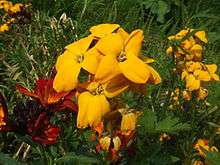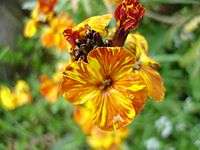Erysimum cheiri
| Erysimum cheiri | |
|---|---|
 | |
| Scientific classification | |
| Kingdom: | Plantae |
| Clade: | Angiosperms |
| Clade: | Eudicots |
| Clade: | Rosids |
| Order: | Brassicales |
| Family: | Brassicaceae |
| Genus: | Erysimum |
| Species: | E. cheiri |
| Binomial name | |
| Erysimum cheiri | |
| Synonyms | |
|
Cheiranthus cheiri | |
Erysimum cheiri syn. Cheiranthus cheiri (common name wallflower) is a species of flowering plant in the family Brassicaceae (Cruciferae), native to Europe but widespread as an introduced species elsewhere. It is also widely cultivated as a garden plant. It is known as giroflée and ravenelle in French, Goldlack in German, alhelí in Spanish and violacciocca in Italian.[1]
Name
The common name "wallflower" attaches to all cultivars of this plant, as well as other species within the genus Erysimum and the former genus Cheiranthus.

Description
This is a herbaceous perennial, often grown as a biennial, with one or more highly branching stems reaching heights of 15–80 cm (6–31 in). The leaves are generally narrow and pointed and may be up to 20 cm (8 in) long. The top of the stem is occupied by a club-shaped inflorescence of strongly scented flowers. Each flower has purplish-green sepals and rounded petals which are two to three centimeters long and in shades of bright yellows to reds and purples. The flowers fall away to leave long fruits which are narrow, hairy siliques several centimeters in length.
Cultivation
This is a popular ornamental plant, widely cultivated for its abundant, fragrant flowers in spring. Many cultivars have been developed, in shades of yellow, orange, red, maroon, purple, brown, white and cream. It associates well in bedding schemes with other spring flowers such as tulips and forget-me-nots. It is usually grown as a biennial, sown one year to flower the next, and then discarded. This is partly because of its tendency to grow spindly and leggy during its second year, but more importantly its susceptibility to infections such as clubroot.[2]
A miniature yellow double leafed wallflower was rediscovered by Rev. Henry Harpur-Crewe (before 1883) and is now named ‘Harpur Crewe’.[3] Other bred varieties may vary quite a bit in appearance from the wild plant. The following cultivars have gained the Royal Horticultural Society’s Award of Garden Merit:-[4]
Other varieties such as 'Blood Red Covent Garden' are easy to grow and often benefit from being sown and left to their own devices, growing on patches of empty land with little effort required to maintain them, providing aesthetically sound blooms which produce strong scents.
References
- ↑ "Erysimum cheiri". Germplasm Resources Information Network (GRIN). Agricultural Research Service (ARS), United States Department of Agriculture (USDA). Retrieved 12 January 2018.
- ↑ RHS A-Z encyclopedia of garden plants. United Kingdom: Dorling Kindersley. 2008. p. 1136. ISBN 1405332964.
- ↑ Cornett, Peggy (January 2000). "In the Company of Gardeners: The Flower Diaries of Jefferson, Skipwith, and Faris". Twinleaf Journal. Retrieved 2 December 2010.
- ↑ "AGM Plants - Ornamental" (PDF). Royal Horticultural Society. July 2017. p. 37. Retrieved 16 February 2018.
- ↑ "RHS Plantfinder - Erysimum cheiri 'Sunset Apricot' (Sunset Series)". Retrieved 16 February 2018.
- ↑ "RHS Plantfinder - Erysimum cheiri 'Sunset Primrose' (Sunset Series)". Retrieved 16 February 2018.
External links
| Wikimedia Commons has media related to Erysimum cheiri. |